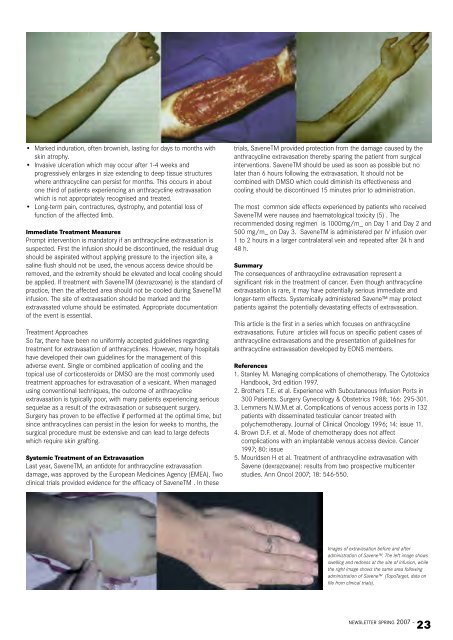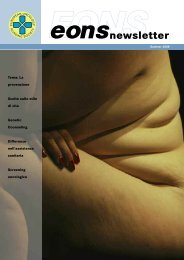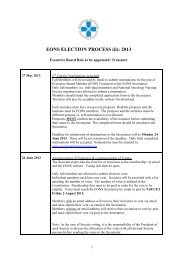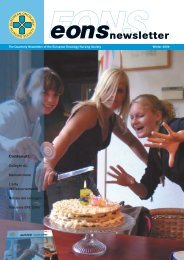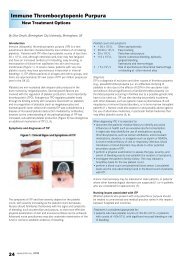Causes, Diagnosis, and Treatment of Extravasation - the European ...
Causes, Diagnosis, and Treatment of Extravasation - the European ...
Causes, Diagnosis, and Treatment of Extravasation - the European ...
Create successful ePaper yourself
Turn your PDF publications into a flip-book with our unique Google optimized e-Paper software.
• Marked induration, <strong>of</strong>ten brownish, lasting for days to months withskin atrophy.• Invasive ulceration which may occur after 1-4 weeks <strong>and</strong>progressively enlarges in size extending to deep tissue structureswhere anthracycline can persist for months. This occurs in aboutone third <strong>of</strong> patients experiencing an anthracycline extravasationwhich is not appropriately recognised <strong>and</strong> treated.• Long-term pain, contractures, dystrophy, <strong>and</strong> potential loss <strong>of</strong>function <strong>of</strong> <strong>the</strong> affected limb.Immediate <strong>Treatment</strong> MeasuresPrompt intervention is m<strong>and</strong>atory if an anthracycline extravasation issuspected. First <strong>the</strong> infusion should be discontinued, <strong>the</strong> residual drugshould be aspirated without applying pressure to <strong>the</strong> injection site, asaline flush should not be used, <strong>the</strong> venous access device should beremoved, <strong>and</strong> <strong>the</strong> extremity should be elevated <strong>and</strong> local cooling shouldbe applied. If treatment with SaveneTM (dexrazoxane) is <strong>the</strong> st<strong>and</strong>ard <strong>of</strong>practice, <strong>the</strong>n <strong>the</strong> affected area should not be cooled during SaveneTMinfusion. The site <strong>of</strong> extravasation should be marked <strong>and</strong> <strong>the</strong>extravasated volume should be estimated. Appropriate documentation<strong>of</strong> <strong>the</strong> event is essential.<strong>Treatment</strong> ApproachesSo far, <strong>the</strong>re have been no uniformly accepted guidelines regardingtreatment for extravasation <strong>of</strong> anthracyclines. However, many hospitalshave developed <strong>the</strong>ir own guidelines for <strong>the</strong> management <strong>of</strong> thisadverse event. Single or combined application <strong>of</strong> cooling <strong>and</strong> <strong>the</strong>topical use <strong>of</strong> corticosteroids or DMSO are <strong>the</strong> most commonly usedtreatment approaches for extravasation <strong>of</strong> a vesicant. When managedusing conventional techniques, <strong>the</strong> outcome <strong>of</strong> anthracyclineextravasation is typically poor, with many patients experiencing serioussequelae as a result <strong>of</strong> <strong>the</strong> extravasation or subsequent surgery.Surgery has proven to be effective if performed at <strong>the</strong> optimal time, butsince anthracyclines can persist in <strong>the</strong> lesion for weeks to months, <strong>the</strong>surgical procedure must be extensive <strong>and</strong> can lead to large defectswhich require skin grafting.Systemic <strong>Treatment</strong> <strong>of</strong> an <strong>Extravasation</strong>Last year, SaveneTM, an antidote for anthracycline extravasationdamage, was approved by <strong>the</strong> <strong>European</strong> Medicines Agency (EMEA). Twoclinical trials provided evidence for <strong>the</strong> efficacy <strong>of</strong> SaveneTM . In <strong>the</strong>setrials, SaveneTM provided protection from <strong>the</strong> damage caused by <strong>the</strong>anthracycline extravasation <strong>the</strong>reby sparing <strong>the</strong> patient from surgicalinterventions. SaveneTM should be used as soon as possible but nolater than 6 hours following <strong>the</strong> extravasation. It should not becombined with DMSO which could diminish its effectiveness <strong>and</strong>cooling should be discontinued 15 minutes prior to administration.The most common side effects experienced by patients who receivedSaveneTM were nausea <strong>and</strong> haematological toxicity (5) . Therecommended dosing regimen is 1000mg/m_ on Day 1 <strong>and</strong> Day 2 <strong>and</strong>500 mg/m_ on Day 3. SaveneTM is administered per IV infusion over1 to 2 hours in a larger contralateral vein <strong>and</strong> repeated after 24 h <strong>and</strong>48 h.SummaryThe consequences <strong>of</strong> anthracycline extravasation represent asignificant risk in <strong>the</strong> treatment <strong>of</strong> cancer. Even though anthracyclineextravasation is rare, it may have potentially serious immediate <strong>and</strong>longer-term effects. Systemically administered Savene may protectpatients against <strong>the</strong> potentially devastating effects <strong>of</strong> extravasation.This article is <strong>the</strong> first in a series which focuses on anthracyclineextravasations. Future articles will focus on specific patient cases <strong>of</strong>anthracycline extravasations <strong>and</strong> <strong>the</strong> presentation <strong>of</strong> guidelines foranthracycline extravasation developed by EONS members.References1. Stanley M. Managing complications <strong>of</strong> chemo<strong>the</strong>rapy. The CytotoxicsH<strong>and</strong>book, 3rd edition 1997.2. Bro<strong>the</strong>rs T.E. et al. Experience with Subcutaneous Infusion Ports in300 Patients. Surgery Gynecology & Obstetrics 1988; 166: 295-301.3. Lemmers N.W.M.et al. Complications <strong>of</strong> venous access ports in 132patients with disseminated testicular cancer treated withpolychemo<strong>the</strong>rapy. Journal <strong>of</strong> Clinical Oncology 1996; 14: issue 11.4. Brown D.F. et al. Mode <strong>of</strong> chemo<strong>the</strong>rapy does not affectcomplications with an implantable venous access device. Cancer1997; 80: issue5. Mouridsen H et al. <strong>Treatment</strong> <strong>of</strong> anthracycline extravasation withSavene (dexrazoxane): results from two prospective multicenterstudies. Ann Oncol 2007; 18: 546-550.Images <strong>of</strong> extravasation before <strong>and</strong> afteradministration <strong>of</strong> Savene. The left image showsswelling <strong>and</strong> redness at <strong>the</strong> site <strong>of</strong> infusion, while<strong>the</strong> right image shows <strong>the</strong> same area followingadministration <strong>of</strong> Savene (TopoTarget, data onfile from clinical trials).NEWSLETTER SPRING 2007 -23


